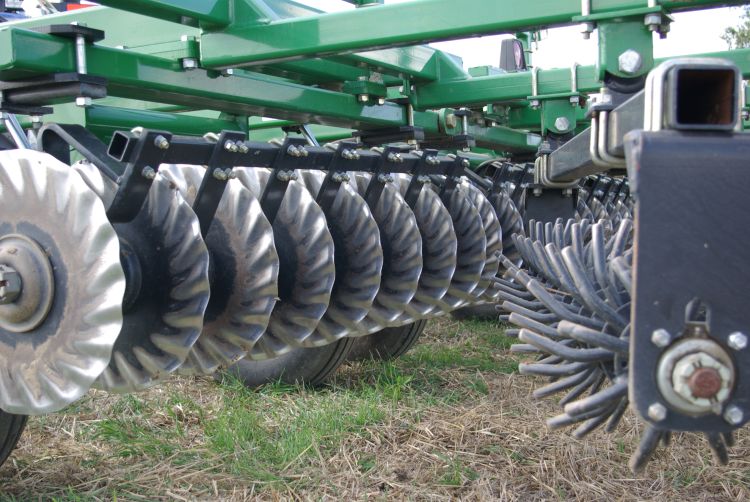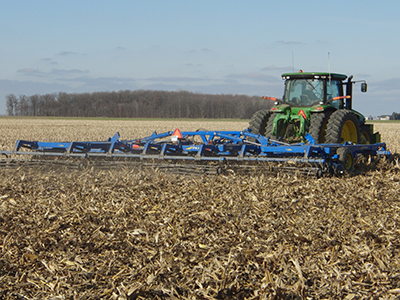Vertical tillage for corn residue management
Low-disturbance tillage can be a valuable tool for field crop farmers.

Drill and planter performance can be hindered by excessive corn residue in the field, which can lead to poor and uneven germination and emergence and reduced yield and profitability. Corn, compared to soybean, takes longer to break down and decompose in the field due to its higher carbon-nitrogen (C:N) ratio. The C:N ratio is a way to evaluate the balance between the two elements. A high C:N ratio (greater than 40:1) will have a slow residue decomposition by microbes due to nitrogen being a potential limiting factor, while a low C:N ratio (less than 25:1) will be faster because nitrogen is not as limiting, so microbes can get their energy source from carbon and build their proteins and enzymes using the nitrogen for cell growth and function.
Over time, there has been more innovation in “vertical” tillage tools and equipment to meet the demands of no-till cropping and managing corn residue, leading to the increased use of coulters and discs. These tools assist with incorporation, improve infiltration and reduce runoff, which assists in lowering nutrient loss following manure or fertilizer application compared to surface broadcasting alone. Unlike more conventional tillage tools, they do not bury much crop residue, but are able to cut it for better distribution, allowing for easier contact with the soil.
Depending on the goals for tillage, different vertical tillage tools may be used. If the main goal is sizing corn residue, less aggressive coulters and toolbars with a zero-degree gang angle can be utilized to distribute residue evenly. However, if the goal is to loosen the soil, increase lateral movement and residue coverage then more aggressive coulters and toolbars with as much as 18 degrees gang angle can be utilized. More aggressive use of the tools or utilizing it for more than one pass may decrease the conservation benefits.
Videos showing the implements, soil and residue conditions can be accessed with the following links:
- Vertical Tillage with Great Plains Turbo Max: VT1100 Turbo Max
- Vertical Tillage Salford RTS, Summers Supercoulter Plus: Salford RTS, Summers SuperCoulter Plus in Spring Corn Residue
- Vertical Tillage with Great Plains Turbo-Till: Great Plains Turbo-Till in Spring Corn Residue
- Fall Vertical Tillage with Landoll 7450: Landoll 7450, Fall Tillage in Corn Stalks
- Vertical Tillage Case IH 330 Turbo: Case-IH 330 Turbo in Spring Desiccated Cereal Rye Cover
- Vertical Tillage Managing Hi-Yielding Corn Residue: Landoll 7431, Managing High-Yielding Corn Residue

What we know
Previous on-farm research on soybean yield in Michigan reported that when comparing soybean yield of fields tilled with the Salford RTS to untilled fields, the tilled fields had a higher yield and an additional $8 per acre income than the untilled fields. The research also reported that vertical tillage had lower yields in another year at other locations but suggested it may have been due to the late soybean planting and drought conditions that year.
Based on results of on-farm field trials conducted in Michigan with soil types from sandy-loams to clay-loams and a range of tillage implements, tillage of corn residue in either spring or fall generally led to more rapid soybean emergence. However, in this study it did not raise the final plant population or soybean yield.
Key findings from the on-farm field trials:
- Fall tillage cut and sized corn residue, but did not significantly reduce the volume (pounds per acre) of residue left on the soil surface at planting time.
- Spring tillage was able to reduce surface residue by approximately 30% due to the residue being dry, easily covered in soil and shattering effortlessly.
- There was no significant benefit from two tillage passes compared to one pass in fall or spring. Two passes in the spring led to large residue reduction in the medium textured, loam soils. The second pass was deeper than necessary, which caused the seedbed to be loose and vulnerable to crusting and excessive drying.
- A single tillage pass to incorporate cereal rye as a cover crop in the fall improved the emergence and uniformity in dry conditions and when the rye was broadcast on firm, trafficked soil with minimal residue cover.
An increase in soybean yields due to fall or spring tillage was not detected. However, numerous corn and soybean growers reported improved planting when using a vertical tillage tool to create a uniform, warm and dry seedbed across the field. This aids in timely planting, emergence, dry-down and maintaining top planter performance at a faster travel speed.
A previous research study conducted in Canada on sandy loam soil examined vertical tillage disc shape types—notched, rippled and plain—and their effects on residue cutting and mixing with the soil. The study reported that the rippled disc mixed the corn residue the best, followed by the plain disc and lastly the notched disc.
The study also reported that there were no big differences between the disc types in the case of residue cutting.
In a different study in Pennsylvania, on-farm trials were conducted comparing vertical tillage and no-till implementations and their effects on soybean grain yield and slug damage. These trials were conducted on fields with silt loam and loam soils. It was reported that vertical tillage and no-till practices did not show any differences in the case of soybean grain yield. However, vertical tillage did result in a reduction of slug damage; that may not mean elimination of the slug population.
Vertical tillage can be an important tool to have in your toolbox and assist in reaching long-term goals for your operation. Contact your local Michigan State University Extension educator for assistance with more in-depth questions.
Original funding for this work was provided by the Michigan Corn and Michigan Soybean Committee. We greatly appreciate the support and cooperation of the growers who helped with this work: John Crumbaugh, Lou Faivor, Jay Ferguson, Jeff Sandborn, Lee Thelen and Eric Voisinet.



 Print
Print Email
Email